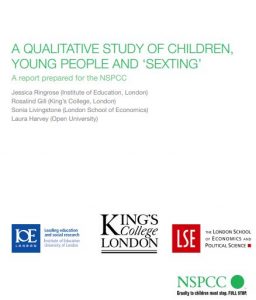Sexting
A Qualitative Study of Children, Young People and ‘Sexting’
 Full Article Name: A Qualitative Study of Children, Young People and ‘Sexting’: A Report Prepared for the NSPCC
Full Article Name: A Qualitative Study of Children, Young People and ‘Sexting’: A Report Prepared for the NSPCC
Open Access: Yes
Abstract
What is sexting? Sexting has been defined as the “exchange of sexual messages or images” and “creating, sharing and forwarding sexually suggestive nude or nearly nude images” (see report for references). Aim of the study In this study, the researchers listened to young people’s views and experiences to gain an understanding of how sexually explicit texts and images are produced, circulated and used through mobile phones and the internet and how these practices shape the offline lives of young people. Methodology The researchers conducted focus groups with 35 young people aged 12 to 14 years from inner city London schools. Participants were asked to become friends with the research team on Facebook so their activities online could be mapped. Follow-up interviews were conducted with 22 of the focus group participants as well as with 4 teachers and 4 school support staff. Key messages The findings reveal that sexting does not refer to a single activity but covers a range of activities experienced by young people. The top messages from the research are: •the primary technology-related threat comes from peers, not ‘stranger danger’ •sexting is often coercive •girls are the most adversely affected •technology amplifies the problem by facilitating the objectification of girls •sexting reveals wider sexual pressures •ever younger children are affected •sexting practices are culturally specific •more support and resources are vital to redress the gendered sexual pressures on young people. The research also sets out recommendations for schools, parents, internet service and site providers, child welfare professionals and future research.
Citation
Ringrose, J., Gill, R., Livingstone, S., & Harvey, L. (2012). A qualitative study of children, young people and ‘sexting’: A report prepared for the NSPCC. London, UK: National Society for the Prevention of Cruelty to Children. http://eprints.lse.ac.uk/id/eprint/44216

